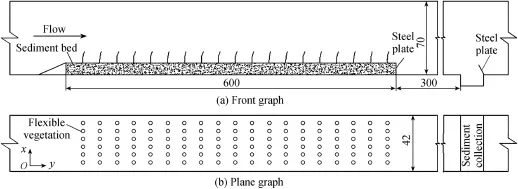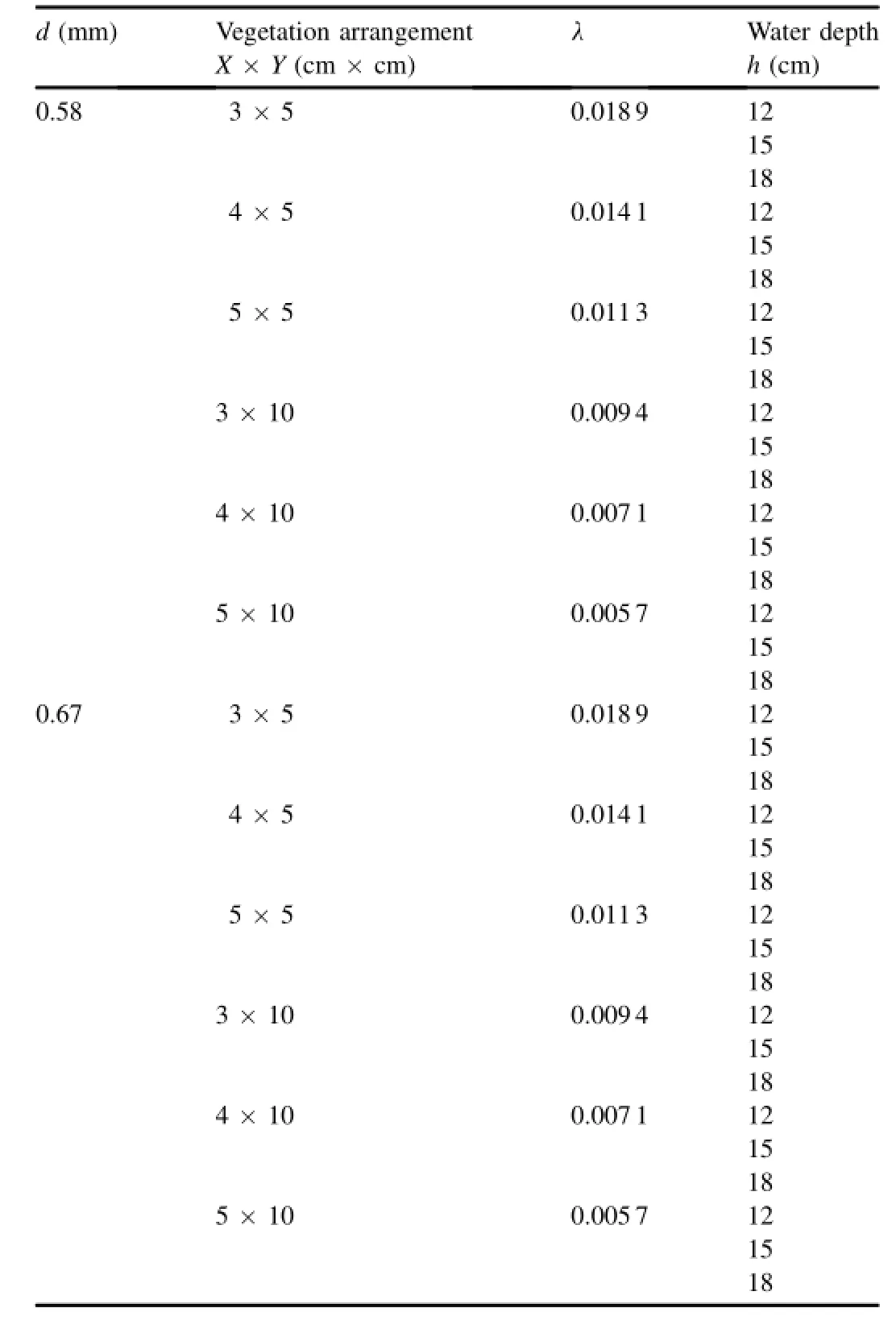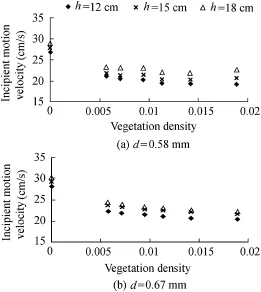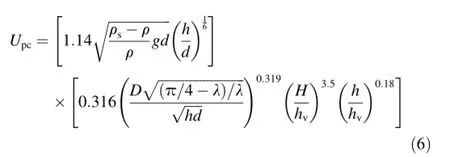Incipientmotion of sediment in presence of submerged flexible vegetation
Hao Wang,Hong-wu Tang*,Han-qing Zhao,Xuan-yu Zhao,Sheng-qi Lu¨State Key Laboratory of Hydrology-Water Resources and Hydraulic Engineering,Hohai University,Nanjing 210098,PR China Received 23 December 2013;accepted 28 May 2014 Available online 17 January 2015
Incipientmotion of sediment in presence of submerged flexible vegetation
Hao Wang,Hong-wu Tang*,Han-qing Zhao,Xuan-yu Zhao,Sheng-qi Lu¨
State Key Laboratory of Hydrology-Water Resources and Hydraulic Engineering,Hohai University,Nanjing 210098,PR China Received 23 December 2013;accepted 28 May 2014 Available online 17 January 2015
Abstract
The presence of submerged vegetation on river beds can change thew ater flow structure and alter the state of sedimentmotion.In this study,the incipientmotion of sediment in the presence of submerged flexible vegetation in open channelswas investigated in a laboratory experiment. The vegetation was simulated w ith flexible rubber cylinders arranged in parallel arrays.The effect of the vegetation density,water depth,and sedimentgrain size on the incipientmotion was investigated.The experimental results indicate that the incipientmotion velocity of sediment increases as the vegetation density decreases and thewater depth and sediment grain size increase.With flexible plants,the incipientmotion velocity of sediment is lower than it isw ithout vegetation,and is larger than it iswith rigid vegetation.A general incipientmotion velocity equation w as derived,which can be applied to both flexible and rigid vegetation conditions. ©2015 Hohai University.Production and hosting by Elsevier B.V.This is an open access article under the CC BY-NC-ND license(http:// creativecommons.org/licenses/by-nc-nd/4.0/).
Sediment incipientmotion;Submerged flexible vegetation;Open channel;Experimentation;Sediment grain size;Water depth
1.Introduction
Aseconomic development continues to cause deterioration in the state of our environment,there is increasing interest in ecologicalmanagement.One of the ecological issues associated w ith river mechanics is the water flow and sediment behavior in the presence of vegetation.The mechanics involving vegetation and sediment is complicated(Stephan and Gutknecht,2002;Kouwen etal.,1981;Tang etal.,2007). The existence of vegetation increases the flow resistance,raises the water depth,and promotes the deposition of sedim ent,and the vegetation may sway w ith the flow pressure,promoting the stirring motion of the flow body,and washing away the sedimentaround the plant.Vegetation on river beds absorbs pollutants in the channels and provides habitat for aquatic animals.A lthough river vegetation p lays an important role in the river ecosystem,research on aquatic vegetation w ithin the framework of rivermechanicshasbeen limited.It is therefore useful to conduct further research thatw ill broaden our understanding of the effect of aquatic vegetation on river flow patterns and sedimentbehavior.
Unlike flow characteristics in open channels w ithout vegetation,the flow velocity distributionw ith vegetation isnot subject to the exponential rule,and anisotropy is significant(Wu,2007).Experiments by Lu¨(2008)showed that the flow velocity distribution isuniform along thewater depth direction in open channelsw ith emergent rigid vegetation.Li and Shen(1973)suggested that the vegetation arrangementon the river bed affects the sediment transport rate.Less sediment is transported when plantsare arranged in a staggered pattern,as comparedw ith the traditionalparallelpattern.Wang andWang(2010)found that vegetation increases the deposition of suspended sediment in water.
This work was supported by the China National Funds for Distinguished Young Scientists(GrantNo.51125034),the State Key Program of theNational Natural Science Foundation of China(Grant No.51239003),and the National NaturalScience Foundation of China(GrantsNo.51109066 and 51109065).
*Corresponding author.
E-mail address:hwtang@hhu.edu.cn(Hong-wu Tang).
Peer review under responsibility of HohaiUniversity.
http://dx.doi.org/10.1016/j.w se.2015.01.002
1674-2370/©2015 Hohai University.Production and hosting by Elsevier B.V.This is an open access article under the CC BY-NC-ND license(http:// creativecommons.org/licenses/by-nc-nd/4.0/).
Generally,studies on the incipient motion of sediment w ithout vegetation from the point of view of the traditional river mechanics exam ine three aspects:the probability of sediment incipientmotion,flow shear stress,and the sediment transport rate(Zhang,1998).Only a few studies have focused on the incipientmotion of sedimentw ith vegetation. Jordanova and James(2003)and Kothyari et al.(2009)compared bed load transport rates in flows with and w ithout vegetation.They found that the incipientmotion of sediment on a vegetation bed and a flat bed(w ithout vegetation)were similar.Tang et al.(2013)studied the incipient motion of sediment in the presence of emergent rigid vegetation,classified the sediment movement process before the sediment reached the incipient motion state into three stages,and defined the third stage as the incipient motion state.They concluded that sediment moved more easily in flow s w ith vegetation,and the bed surface was deform ed before the sedim ent reached the stage of incipientm otion.Wang et al.(2014)showed that when the sediment was in the stage of incipientmotion,the bed shear stress could be divided into two parts:the grain shear stressand the shear stress caused by sand dunes,which are the bed form after ithasbeen deformed by the sediment incipientmotion.The criterion for the sediment incipientmotion adopted in Tang etal.(2013)andWang etal.(2014)is similar to thatw ithout vegetation proposed by Kramer(Zhang,1998),i.e.,themomentwhen there are few countable sedim ent particles on the bed beginning to move. Both of them are qualitative but can express the stage of the incipientmotion of sedimentvery well.This study isbased on the criterion described above.
Even thoughmostvegetation found on riverbeds is flexible,studieson theeffectsof flexibleplantson the flow and sediment behavior,such as the incipientmotion of sediment in thewater channel,are rare.In this study we investigated the incipient motion of sediment in an open channel that contain submerged flexible vegetation,which were represented by arrays of thin rubber cy lindersarranged in a regular pattern.We exam ined the factors influencing the incipientmotionvia changes invegetation density,water depth,and sediment grain size.Based on comparisonof the resultsfor rigidand flexiblevegetation,wederivea general equation for the incipientmotion velocity of sediment thatcan beapplied to both rigid and flexiblevegetation.

Fig.1.Experimental flume and vegetation arrangement(units:cm).
2.M aterials and m ethods
The experiment was carried out in a tilting rectangular flume,12m long,0.42m w ide,and 0.7 m deep(Tang et al., 2013),w ith am arble bottom and glass sidewalls for observing the state of the sediment.The flum e was connected to a tank through a pump,which controlled the water discharge to the flume.A sluice at the end of the flume controlled the discharge out of the flume.Different uniform flows were achieved by adjusting thewater pump,sluice,and flume slope.The quartz sand used in the experimentwas collected from the Nanjing reach of the Yangtze River.The sand wasgraded according to its particle diameter d;two diameters were selected for the experiment:d=0.58mm and d=0.67mm,and the relative density was(ρs-ρ)/ρ=1.65,whereρsis the density of sediment,andρis the density of water.The sedim ent used herein was the same as that in Tang etal.(2013).The incipient m otion velocity w ithout vegetation was calculated w ith the equation ofΓ.И.ЩаМов(in Russian)(Zhang,1998).
A 6m-long section in themiddle of the flumewas selected as the experiment zone(Fig.1).To simulate vegetation accurately in ageometric configuration,thin rubber cylindersw ith a heightof 12 cm,a diameter of 0.6 cm,and stiffness similar to thatofnaturalplants,wereused to imitate thevegetation on the river bed.A horizontal plastic board w ith holes of 1 cm apart served as a base for fixing the artificial plants.Once the simulated plants were set in the board,a 5 cm-thick layer of sand was spread over the board.The actual length of the vegetation inwaterwas H=6 cm.As the number of holes in theboardwas larger than thenumberof plants,the density and pattern of the vegetation could be changed by altering the number of holes between the adjacent plants.The plantswere arranged in the holesaccording to the given vegetation density λ(Table 1),defined as(Tang etal.,2013): where D is the diameter of the vegetation,and X and Y are the distance between the centers of adjacent plants in the x and y directions,respectively.


Combining the vegetation densityλw ith the discharge Q obtained from the pump monitor,the average flow velocity u in the vegetation zone can be derived from the follow ing equation(Yan,2008;Stone and Shen,2002):where B is the flumew idth,and hvis the heightof the flexible vegetation under the flow force.Eq.(2)was adopted to calculate the incipientmotion velocity when sedimentswere in a stage of incipientmotion.We conducted a series of experiments where the vegetation corresponding to the sediment incipient motion was in a state of swaying motion.We assumed that the height of the vegetation in thewater and the vegetation density did not change w ith the flow conditions(Kuowen and Unny,1973).Here,hv=5.7 cm.
Initially,thewaterwas pumped into the flume slow ly while the sluice gatewas closed,so that thewater could infiltrate the sand w ithout disturbing it.The discharge could be raised gradually,and the flume slope and the opening of the sluice gatewas adjusted rapidly to keep the flow uniform and stable while ensuring a fixed water depth.This step was repeated until incipientmotion of sediment occurred,and at this time,the discharge Q was recorded.Incipient motion is defined,according to Tang et al.(2013),as noticeable sediment transport out of the scour holes and outside the vegetation zone.Sediment m ovement begins at this stage described above,but it is very m inimal.

Table 1 Summary of experimental conditions.
3.Results and discussion
3.1.Influence of vegetation density and water depth on incipientmotion of sediment
Fig.2 shows the experimental results of the incipientmotion velocity of sediment from 36 cases w ith submerged flexible vegetation and results calculated w ith the equation of Γ.И.ЩаМов(in Russian)(Zhang,1998)in flow w ithout vegetation.
Fig.2 indicates that the sediment incipientmotion velocity Upcis related to the vegetation densityλ,and show s a decreasing trend w ith increasingλ,in contrast to the positive correlation between Upcand the water depth and sediment grain size.Themotion of thevegetation in response to the flow force(Kuowen and Unny,1973)disturbs thewater body and causes the sand to move.Additionally,the downward flow along the plant'supstream face scours the rootof theplantand shifts thesedimentthere.Thisaction becomesmoresignificant asλincreases.For deep flow depths,the relative heightof the vegetation is low,the planteffectsmay notbe as significantas in shallow water,and Upcw ill increase.Larger-size sand grains are harder to move in flow w ith or w ithout vegetation. The observed value of Upcis at least 20%lower in flow through submerged flexible vegetation than that in flow w ithout vegetation calculated using the equation of Γ.И.ЩаМов(in Russian)(Zhang,1998),as shown in Fig.2. This indicates that the existence of submerged flexible vegetation can promote sediment transport to some extent.

Fig.2.Incipientmotion velocity of sediment in different conditions.
3.2.Incipientmotion velocity of sediment in flowswith rigid and flexible vegetation
We compared some of our experimental data of the incipient sedimentmotion velocity in flow w ith flexible vegetation w ith thosew ith rigid vegetation(Tang etal.,2013),assuming that the other experimental conditions were similar.Theresults show that Upcin flow w ith flexible vegetation is generally higher than Upcw ith rigid vegetation(Fig.3). Hence,the equation that applies to flow w ith rigid vegetation cannotbe applied to flow w ith flexible vegetation.
We can analyze this phenomenon based on the rule of conservation of energy.In flow w ith rigid vegetation,the upstream kinetic energy is used to maintain the motion of the downstream flow,sediment transport,and to some extent the dissipation of the stirring motion.In flow w ith flexible vegetation,in addition to theabove functions,someof the energy is dissipated by theplant'sswayingmotion.Tomaintain thesame state of m otion,much more energy is required in flow w ith flexible vegetation than w ith rigid vegetation.Moreover,w ith rigid vegetation,the downward flow at the plant's upstream face is vertical to the bed.Flexible vegetation tends to bend w ith the flow force.Thus,the downward flow suffers the resistance force from the swaying of flexible vegetation.This force restrains sedimentmotion.Hence,compared w ith rigid vegetation,flexible vegetation has a positive effecton control of flow scouring by absorbing more energy w ith itsmotion.

Fig.3.Incipientmotion velocity of sediment in flowsw ith rigid and flexible vegetation.

Fig.4.Comparison of experimental and calculated incipientmotion velocities of sediment.
3.3.Equation of incipientmotion velocity of sediment in presence of vegetation
Tang et al.(2013)defined the incipientmotion velocity of sediment in the presence of emergent rigid vegetation as

where k,a1,a2,and a3are constants,and CLand Cdare coefficients for the lift force and drag force,respectively,when the bed load interacts w ith currentm oving.Their result was based on research on rigid vegetation.In flow w ith subm erged flexible vegetation,Upcis also related to h/hvand H/hv,and can be expressed as

where h/hvindicates the relative degree of submergence,and H/hvindicates thew inding level.
Substituting theexperimentaldata into Eq.(4),the incipient motion velocity of sediment in the presence of submerged flexible vegetation can be derived:

The first part on the right side of Eq.(5)represents the incipient motion velocity of sediment in emergent rigid vegetation conditions;the second part reflects the factors that depend on the characteristicsof the flexiblevegetation.For the emergent rigid plant,the second expression is constant and is equal to 1.Fig.4 presentsa comparison between the observed values of Upcand those calculated w ith Eq.(5).The velocity Upcdepends on the relative degree of submergencewhile the p lant sways in the water.According to Kuowen and Unny(1973),the vegetation changes from swaying m otion to a constant oblique condition when the flow velocity increases. Therefore,while in this study we focused on swaying vegetation,further study on Upcaround vegetation in an oblique condition should be carried out.
Eq.(5)can be rew ritten as

based on the equation ofΓ.И.ЩаМов(in Russian),which is fitted for the incipient motion velocity of sedim ent w ithoutvegetation.The equation ofΓ.И.ЩаМов(in Russian)only includes the first part on the right side of Eq.(6).The second part is the vegetation factor.Setting the value of the vegetation factor to 1 yields the following equation:

In contrast to thatof emerged rigid vegetation(Tang etal.,2013),the vegetation factor of submerged flexible vegetation consists of the winding level and the relative degree of submergence in different flow conditions.Eq.(7)appears to be a critical equation.If the value of the vegetation factor is less than 1,the effect of vegetation isnotnegligible.Therefore,the vegetation factor is a key factor that determ ines whether the vegetation has influence on the incipient motion velocity of sediment.In fact,the value of the vegetation factor could be greater than 1.For a significantwater depth,when the height of vegetation is less than a threshold value,the vegetation factor is greater than 1.In this case,the vegetation can be regarded as roughness elements,the influence of the vegetation on sediment transport can be ignored,and the vegetation factor can be considered 1.In fact,the vegetation factor is the parameter that describes the relationships between plants,the water depth,the density of vegetation,and the sediment in the influenced zone.
4.Conclusions
We conducted laboratory experiments to investigate the factors that affect the incipientmotion of sediment on river beds.Ourmain conclusions are as follows:
(1)The plant density and the relative degree of submergence influence the incipientmotion velocity of sediment in the presence of submerged flexible vegetation.The incipient m otion velocity of sediment increases as the plant density decreases and the water depth and sediment grain size increase.
(2)With flexible plants,the value of incipientmotion velocity of sediment is lower than that in the case w ithout vegetation,but is larger than it isw ith rigid vegetation.
(3)A general incipientmotion velocity equation(Eq.(6))was derived,which can be applied to both rigid and flexible vegetation.
(4)Factors such as the pattern of vegetation grow th on the bottom,the p lantdim ensions,and the vegetation statewere not investigated in this study.Further study on incipientmotion of sediment in the presence of vegetation should focus on these aspects.
References
Jordanova,A.A.,James,C.S.,2003.Experimental study of bed load transport through emergent vegetation.J.Hydraul.Eng.129(6),474-478.http:// dx.doi.org/10.1061/(ASCE)0733-9429(2003)129:6(474).
Kothyari,U.C.,Hashimoto,H.,Hayashi,K.,2009.Effectof tall vegetation on sediment transport by channel flow s.J.Hydraul.Res.47(6),700-710. http://dx.doi.org/10.3826/jhr.2009.3317.
Kouwen,N.,Li,R.M.,Simons,D.B.,1981.Flow resistance in vegetated waterways.Trans.ASABE 24(3),684-698.http://dx.doi.org/10.13031/ 2013.34321.
Kuowen,N.,Unny,T.E.,1973.Flexible roughness in open channels.J. Hydraul.Div.99(5),713-728.
Li,R.M.,Shen,H.W.,1973.Effectof tall vegetations on flow and sediment.J. Hydraul.Div.99(5),793-814.
Lu¨,S.Q.,2008.Experimental Study on Suspended Sediment Distribution in Flow w ith Rigid Vegetation.Ph.D.Dissertation.HohaiUniversity,Nanjing(in Chinese).
Stephan,U.,Gutknecht,D.,2002.Hydraulic resistance of submerged flexible vegetation.J.Hydrol.269(1-2),27-43.http://dx.doi.org/10.1016/S0022-1694(02)00192-0.
Stone,B.M.,Shen,H.T.,2002.Hydraulic resistance of flow in channelsw ith cylindrical roughness.J.Hydraul.Eng.128(5),500-506.http:// dx.doi.org/10.1061/(ASCE)0733-9429(2002)128:5(500).
Tang,H.W.,Yan,J.,Lu¨,S.Q.,2007.Advances in research on flows w ith vegetation in river management.Adv.Water Sci.18(5),785-792(in Chinese).
Tang,H.W.,Wang,H.,Liang,D.F.,Lu¨,S.Q.,Yan,J.,2013.Incipientmotion of sediment in the presence of emergent rigid vegetation.J.Hydro-environ. Res.7(3),202-208.http://dx.doi.org/10.1016/j.jher.2012.11.002.
Wang,C.,Wang,C.,2010.Turbulent characteristics in open-channel flow w ith emergent and submerged macrophytes.Adv.Water Sci.21(6),816-822(in Chinese).
Wang,H.,Tang,H.W.,Yuan,S.Y.,Lu¨,S.Q.,Zhao,X.Y.,2014.An experimental study of the incipient bed shear stress partition in mobile bed channels filled w ith emergent rigid vegetation.Sci.China-Technol.Sci. 57(6),1165-1174.http://dx.doi.org/10.1007/s11431-014-5549-6.
Wu,F.S.,2007.Flow resistance of flexible vegetation in open channel.J. Hydraul.Eng.38(s1),283-287(in Chinese).
Yan,J.,2008.Experimental Study on Flow Resistance and Turbulence Characteristics of Open Channel Flowsw ith Vegetation.Ph.D.Dissertation.HohaiUniversity,Nanjing(in Chinese).
Zhang,R.J.,1998.M echanics of River Sediment,second ed.China Water-Power Press,Beijing(in Chinese).
 Water Science and Engineering2015年1期
Water Science and Engineering2015年1期
- Water Science and Engineering的其它文章
- Temporal variations of reference evapotranspiration and its sensitivity tometeorological factors in Heihe River Basin,China
- An integrated measurement and modeling methodology for estuarinewater quality management
- A continuing 30-year decline in water quality of Jiaojiang Estuary,China
- Evaluation,prediction,and protection of water quality in Danjiangkou Reservoir,China
- Toxicity of perfluorononanoic acid and perfluorooctane sulfonate to Daphniamagna
- Application of subsurfacewastewater infiltration system to on-site treatment of domestic sewage under high hydraulic loading rate
